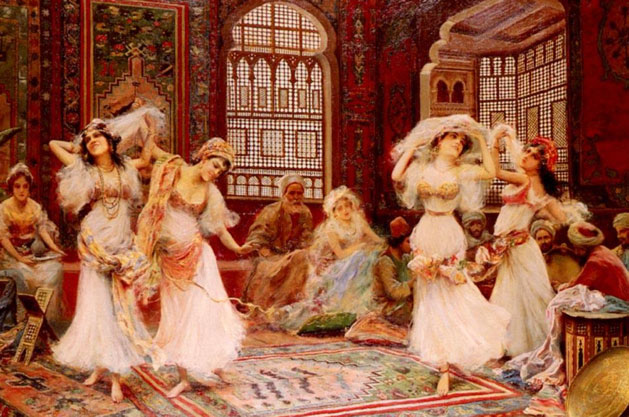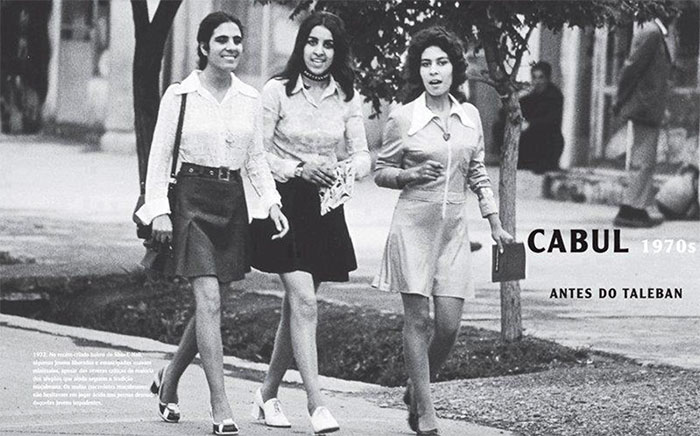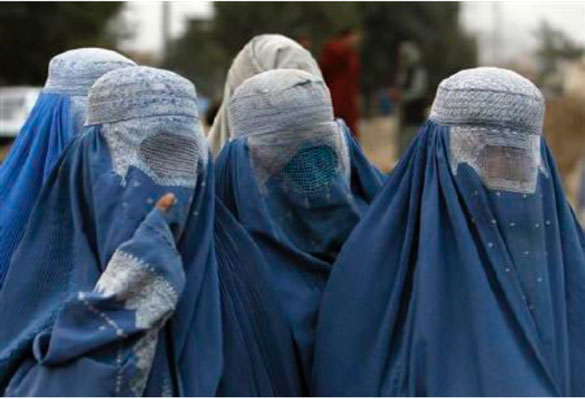By the 18th century during the colonial era, Europeans, men and women, of all walks of life, were sure and of one mind that Muslim women were oppressed by their religion and culture. The European standard list of oppressions facing Muslim women is long and includes the practice of polygamy, laws of divorce, laws of inheritance, laws of witness, gender separation, and the status of Muslim women in marriage. Women’s bodies and clothing were always used by the West as the social and political battleground with Islam and dominated the Western public discourse about “Women in Islam.”
 Muslim women were depicted by Orientalists in fantasized “harem” life where women are presented as the “locus of an exotic and abnormal sexuality” with images of belly dancers to satisfy men’s lust and entertainment. Muslim women were seen oppressed by taking away their intellectual potential. The West manufactured the idea that harem is a system that permits males sexual access freely to more than one female and “women to have frequent and easy access to other women.” By the 20th century, the Islamic institution of veiling had for the most part replaced that Western imagination of fantasized harem life, but with the same underlying dynamic of the Western discourse of “Women in Islam.” Veil has now been used to highlight an oppression and degradation of women who have been deprived of her basic rights and freedoms by Islam and Muslim men. In fact, the veil became the Western shorthand for degraded status of any woman and a metaphor of degeneracy of the entire Muslim world. As we can see, the general Western view of Islam and Muslims, one in which the totality of Muslim beliefs and practices, and even the entire Islamic civilization is reduced to “Western perceptions and assessment of the male-female dynamic.” We now know that the veil as a symbol of Muslim women’s oppression discourse “has its roots in a Eurocentric vision of the world that would have West as superior and non-West inferior.”
Muslim women were depicted by Orientalists in fantasized “harem” life where women are presented as the “locus of an exotic and abnormal sexuality” with images of belly dancers to satisfy men’s lust and entertainment. Muslim women were seen oppressed by taking away their intellectual potential. The West manufactured the idea that harem is a system that permits males sexual access freely to more than one female and “women to have frequent and easy access to other women.” By the 20th century, the Islamic institution of veiling had for the most part replaced that Western imagination of fantasized harem life, but with the same underlying dynamic of the Western discourse of “Women in Islam.” Veil has now been used to highlight an oppression and degradation of women who have been deprived of her basic rights and freedoms by Islam and Muslim men. In fact, the veil became the Western shorthand for degraded status of any woman and a metaphor of degeneracy of the entire Muslim world. As we can see, the general Western view of Islam and Muslims, one in which the totality of Muslim beliefs and practices, and even the entire Islamic civilization is reduced to “Western perceptions and assessment of the male-female dynamic.” We now know that the veil as a symbol of Muslim women’s oppression discourse “has its roots in a Eurocentric vision of the world that would have West as superior and non-West inferior.”
 Unfortunately, it was not just the West that was convinced of the veil’s alleged oppressive nature, “elites” in Muslim countries like Egypt, Iran, Tunisia, Afghanistan, and Turkey internalized the European understanding of certain practices, such as the veil and harem, in their efforts to “modernize.” The continued the Colonial discourse which introduced ideas about Oriental inferiority and the focus on women’s status as the benchmark for progress. Unveiling Muslim women became a central urgency for elites attempting to “catch up” with the West and women occupied the center stage of social, economic, and political reforms of modern Muslim states. Thus, the “veil” became a powerful symbol to differentiate progress or regress of a nation, and anti-veil attack started by the elites on the older meaning of veil as a sign of modesty and piety and took new meaning as a symbol of oppression and degradation. In the 20th century, modernizers in Turkey, Egypt, Tunisia, Iran, and Afghanistan forced women to unveil. Even among conservative Gulf States, campaign against the veil began. In Kuwait, medical students were banned wearing traditional face veil. With arrival of Iranian Revolution and Taliban government in Afghanistan, veil was viewed as an important symbol of Islam and Muslim society, and women were forced to veil. As we entered the 21st century post-9/11, woman’s dress became a battle ground for foreign interventions. When domestic and international support for US “War on Terror” waned, freeing the oppressed Afghani women was used as the justification for the Western military intervention in Afghanistan. Laura Bush used her husband’s weekly radio slot “to kick off a worldwide effort to focus on the brutality against women and children” in Afghanistan.
Unfortunately, it was not just the West that was convinced of the veil’s alleged oppressive nature, “elites” in Muslim countries like Egypt, Iran, Tunisia, Afghanistan, and Turkey internalized the European understanding of certain practices, such as the veil and harem, in their efforts to “modernize.” The continued the Colonial discourse which introduced ideas about Oriental inferiority and the focus on women’s status as the benchmark for progress. Unveiling Muslim women became a central urgency for elites attempting to “catch up” with the West and women occupied the center stage of social, economic, and political reforms of modern Muslim states. Thus, the “veil” became a powerful symbol to differentiate progress or regress of a nation, and anti-veil attack started by the elites on the older meaning of veil as a sign of modesty and piety and took new meaning as a symbol of oppression and degradation. In the 20th century, modernizers in Turkey, Egypt, Tunisia, Iran, and Afghanistan forced women to unveil. Even among conservative Gulf States, campaign against the veil began. In Kuwait, medical students were banned wearing traditional face veil. With arrival of Iranian Revolution and Taliban government in Afghanistan, veil was viewed as an important symbol of Islam and Muslim society, and women were forced to veil. As we entered the 21st century post-9/11, woman’s dress became a battle ground for foreign interventions. When domestic and international support for US “War on Terror” waned, freeing the oppressed Afghani women was used as the justification for the Western military intervention in Afghanistan. Laura Bush used her husband’s weekly radio slot “to kick off a worldwide effort to focus on the brutality against women and children” in Afghanistan.  Cherie Blair followed Bush’s lead a few days later, saying, “We need to free that spirit and give them their voice back.” Ironically what seems to be common between the puritans, the modernists, and the West, is the use of force to veil and unveil a Muslim woman. Unfortunately, post-9/11 has witnessed a dramatic backlash against Islam and Muslims around the globe. Islamophobic narratives are a common feature of Western media about Islam with focus mainly “sensational” issues of Muslim women potentially threatening Western societies due to the presence of Muslim migrants. Hijab, forced marriage, child marriage, polygamy, female genital mutilation, stoning of women, honor killings, deprived women from education, etc. are the usual “talking points.” Any cultural misbehavior of a Muslim is attributed to Islam. Veil has become the symbol of Islam and veiled women are seen to pose cultural and security threats to European values and lifestyle.
Cherie Blair followed Bush’s lead a few days later, saying, “We need to free that spirit and give them their voice back.” Ironically what seems to be common between the puritans, the modernists, and the West, is the use of force to veil and unveil a Muslim woman. Unfortunately, post-9/11 has witnessed a dramatic backlash against Islam and Muslims around the globe. Islamophobic narratives are a common feature of Western media about Islam with focus mainly “sensational” issues of Muslim women potentially threatening Western societies due to the presence of Muslim migrants. Hijab, forced marriage, child marriage, polygamy, female genital mutilation, stoning of women, honor killings, deprived women from education, etc. are the usual “talking points.” Any cultural misbehavior of a Muslim is attributed to Islam. Veil has become the symbol of Islam and veiled women are seen to pose cultural and security threats to European values and lifestyle.
 The West still use the image of a fully veiled Afghan or Saudi woman to illustrate the representation of a Muslim woman. They fail to see the correct image of a Muslim woman as an educated, independent, professional, responsible, achiever, leader, participant, and a decision-maker, both at her home with her family and outside home at the working place and society at large. The debate of “Women in Islam” keeps overshadowing any efforts towards a better understanding between Islam and the West. More often, Western discourse on “Women in Islam” reveals a high degree of ignorance the West carry not only about Muslim women, but also about Islam itself. There has been many contemporary Western studies and writings about Muslim women some of which are genuine, but they are all quite unrepresentative to the reality and misleading. Many of these studies and writings have very narrow focus and based on selected countries that have access. Most of the studies are limited in scope. There is always over-generalization of woman’s subordination to religion or to man and women’s poor conditions. Simplistic approaches are taken on studying complex issues and societies. There is always a failure to understand women’s local values and virtues. New revelation on “Women in Islam” came from Ayse Bohurler, a Turkish journalist, who in 2006 visited many Muslim countries to study Muslim women. She interviewed over 200 women from different classes and produced a multi-series TV documentary, “Behind Walls – Women in the Muslim Countries.” She concluded that, contrary to the Western assumption, there is no single Muslim woman prototype to generalize “Women in Islam” or to represent the condition of all Muslim women in the Muslim world. Interpretation and implementation of Islamic principles about women vary due to the cultural, geographical, economical, and ideological differences in the Muslim countries (and I would add the level of education and development). Each country has its own women reform program according to their local circumstances.
The West still use the image of a fully veiled Afghan or Saudi woman to illustrate the representation of a Muslim woman. They fail to see the correct image of a Muslim woman as an educated, independent, professional, responsible, achiever, leader, participant, and a decision-maker, both at her home with her family and outside home at the working place and society at large. The debate of “Women in Islam” keeps overshadowing any efforts towards a better understanding between Islam and the West. More often, Western discourse on “Women in Islam” reveals a high degree of ignorance the West carry not only about Muslim women, but also about Islam itself. There has been many contemporary Western studies and writings about Muslim women some of which are genuine, but they are all quite unrepresentative to the reality and misleading. Many of these studies and writings have very narrow focus and based on selected countries that have access. Most of the studies are limited in scope. There is always over-generalization of woman’s subordination to religion or to man and women’s poor conditions. Simplistic approaches are taken on studying complex issues and societies. There is always a failure to understand women’s local values and virtues. New revelation on “Women in Islam” came from Ayse Bohurler, a Turkish journalist, who in 2006 visited many Muslim countries to study Muslim women. She interviewed over 200 women from different classes and produced a multi-series TV documentary, “Behind Walls – Women in the Muslim Countries.” She concluded that, contrary to the Western assumption, there is no single Muslim woman prototype to generalize “Women in Islam” or to represent the condition of all Muslim women in the Muslim world. Interpretation and implementation of Islamic principles about women vary due to the cultural, geographical, economical, and ideological differences in the Muslim countries (and I would add the level of education and development). Each country has its own women reform program according to their local circumstances.
Bibliography
Lyons, Jonathan. 2012. Islam Through Western Eyes: From Crusades to the War on Terrorism. New York: Columbia University Press.
Ahmed, Leila. 1982. “Western Ethnocentrism and Perception of the Harem.” Feminist Studies 8 (3): 521-534.
Bullock, Katherine. 2010. Rethinking Muslim Women and the Veil: Challenging Historical & Modern Stereotypes. Surrey: The International Institute of Islamic Thought.
Hussein, Shakira. 2013. “From Rescue Missions to Discipline: Post-9/11 Western Political Discourse on Muslim Women.” Australian Feminist Studies 28 (76): 144-154.
Argit, Betul Ipsirli. 2020. Life After the Harem: Female Palace Slaves, Patronage, and the Imperial Ottoman Court. Cambridge: Cambridge University Press.
Bohurler, Ayse. 2006. Documentary: Behind Walls - Women in the Muslim Countries. Accessed April 22, 2021. https://www.youtube.com/watch?v=_LObD04tQmo.